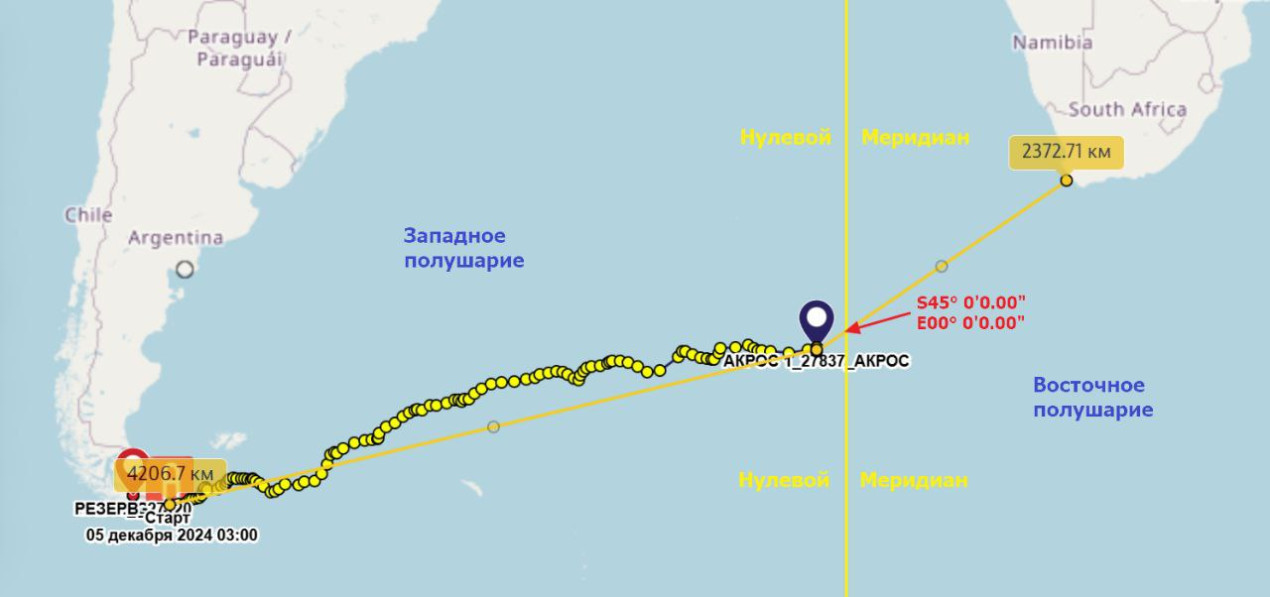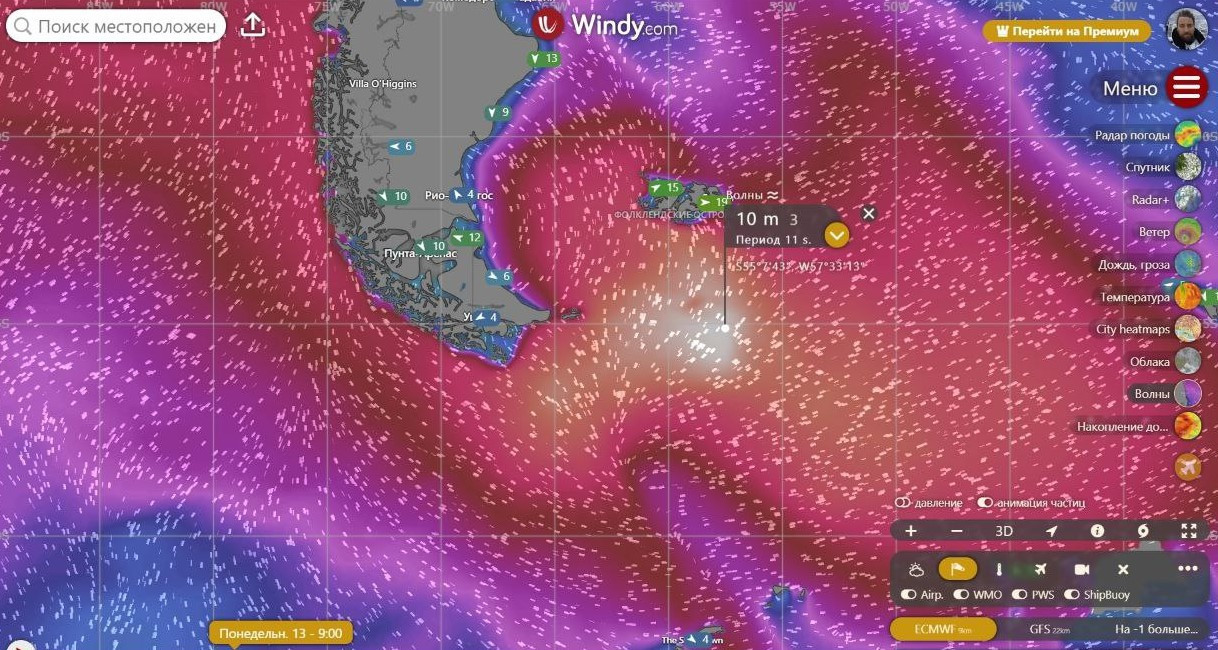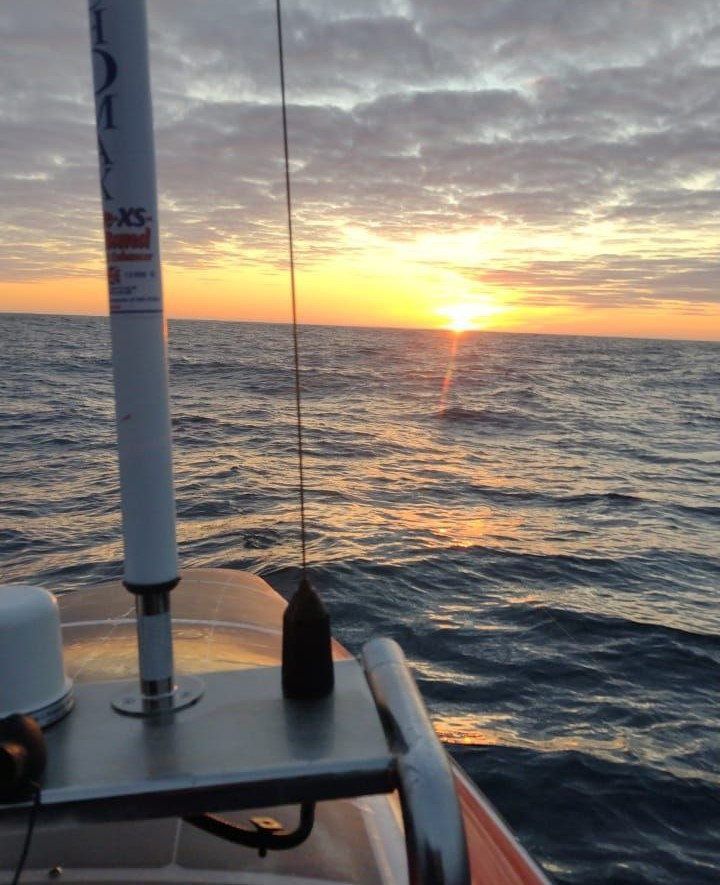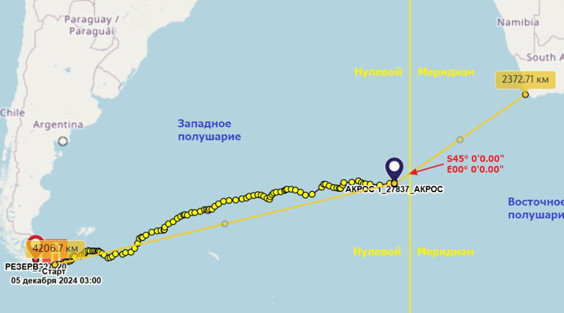
Rowing boat "AKROS" at the very border of the Eastern Hemisphere. Photo: Fedor Konyukhov’s expedition headquarters
Fedor Konyukhov achieved an important symbolic milestone during his solo voyage on the rowing boat «AKROS». It happened around three o’clock in the morning on January 27, on the 53rd day of being in the ocean. The prime meridian, or Greenwich Meridian, is the boundary between the Western and Eastern Hemispheres. In total, more than 2,800 nautical miles (approximately 5,200 km) have been covered since the beginning.
«I have not been to the Eastern Hemisphere since November 1, 2024 (the day of the flight from Moscow to Buenos Aires). The ocean is greeting me harshly, the weather is deteriorating. According to the forecast, the wind is under 40 knots today and tomorrow, it will create big waves,» the traveler reported to his coastal headquarters.
The expedition began on December 5, 2024. The famous Russian traveler and honorary member of the Russian Geographical Society plans to sail alone on a rowing boat «AKROS» from Cape Horn (Chile) to Cape Leeuwin (Australia). The distance will be over 15,000 km. The approximate travel time is about 200 days.
Oskar Konyukhov, the expedition’s chief of staff and the traveler’s son, told «RIA Novosti» that all onboard systems, including navigation devices and a solar-powered seawater desalinator, are working properly. Fedor Filippovich is in a great mood. And this is despite the fact that the weather was cloudy and cold for most of the way, and once the traveler had already experienced a storm that began at sunset on January 17 and lasted more than a day.
«I was lying in the aft compartment, I couldn’t get up, my weight is important in balancing the boat. I wasn’t worried that the wind and waves could damage the boat, it’s sturdy, and the biggest danger is capsizing on a big wave. In 2019, I capsized three times in this boat in the South Pacific Ocean, all three times on the final leg on the approach to Cape Horn,» Fedor Konyukhov reported at the time.
By the evening of January 18, the wind began to subside, but the waves, according to the traveler, increased to 5-6 m. The water mountains were moving across the ocean surface at high speed. The boat would be lifted up, and then flow noisily down, and this happened many times. According to the expedition headquarters, this was the first serious test for the vessel after comprehensive repairs and modifications.

A map of the waves in the Southern Ocean on the expedition route. Photo: Oskar Konyukhov
«The ocean is harsh, yes, it’s cold and damp, but what I see and feel here can only be felt by one person in billions, I’m the only one who sees all this beauty. Of course, already being 73 years old, I think whether I will ever see this ocean again, ever get to these latitudes, especially on a rowing boat. Probably not anymore. Even if one day I get to the Southern Ocean, it will be on an expedition yacht or on a ship, but not on oars,» Fedor Konyukhov said in another message.
Another significant milestone for the traveler was the 46th day of sailing. In 2002, Konyukhov crossed the Atlantic in 46 days on the «UralAZ» rowing boat, starting in the Canary Islands and finishing in Barbados. Then he traveled about 2,800 nautical miles.
«Here in the South Atlantic, I have traveled approximately 2,440 nautical miles in 46 days. It turns out that I’m 500 miles behind schedule in the North Atlantic, or about 10 days,» the traveler noted.

On one of the rare days of the expedition, when the sun came out on the horizon and the sea was calm. Photo: Fedor Konyukhov
However, there is an explanation for this. In 2002, the weather was perfect for the voyage, the trade winds «worked» for a month without a break.
«The difficulty of the Southern Ocean is that when it’s windy here, the wind is so strong that it is dangerous to work on deck, and the waves are such that there is a risk of breaking the oars. And when the wind subsides, it usually starts moving in the opposite direction, and you start fighting the headwind, and to somehow move you have to go off course,» Fedor Filippovich told the members of his coastal headquarters.
The main helper of the traveler is the Antarctic Circumpolar Current. This current, the most powerful on the planet, will accompany the boat for most of the route, one third of which has already been completed.
«The next landmark for me is the longitude of the Cape of Good Hope, the distance to which is 18 degrees in a straight line. This longitude marks the symbolic boundary between the South Atlantic and the Indian Ocean. I hope to complete this part of the journey with God’s help,» the traveler said.
You can follow the whereabouts of Fedor Konyukhov here.
Nikolai Sumarokov


